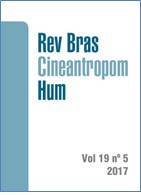Reprodutibilidade da frequência cardíaca e percepção de demandas do treinamento baseado em jogos em atletas de handebol
DOI:
https://doi.org/10.1590/1980-0037.2017v19n5p515Resumo
O treino através do jogo é popular quando se trata de esportes coletivos. Contudo, constata-se uma falta de estudos específicos sobre a prática do handball. Objetivou-se testar a reprodutibilidade de um jogo com equipe reduzida através da análise da frequência cardíaca (FC), do tempo decorrido nas diversas faixas de intensidade de FC e da percepção do esforço. A reprodutibilidade do jogo com equipe reduzida foi comparada àquelas de um exercício padrão de corrida e de um jogo de handball. Quatorze jogadores de handball masculino nível elite realizaram um mesmo exercício em duas ocasiões com uma semana de intervalo entre elas. Cada exercício foi realizado em dois períodos de 10 minutos com dois minutos de intervalo entre cada um. Os diferentes exercícios consistiram numa corrida intermitente de 30s-30s, realizadas em ida e volta (ISR); um jogo com equipe reduzida intermitente de 30s-30s (com três jogadores em cada equipe, 3vs3); e um jogo de handball (com 6 jogadores em cada equipe, 6vs6). A FC média demonstrou um nível avançado de reprodutibilidade dos três exercícios (r = 0,86-0,89; TEM = 2,21-2,63 bpm; CV = 1,23-1,55%). No que se refere ao tempo decorrido nas diferentes faixas de FC, os erros típicos de medição (ETM) foram 1,12, 1,40 e 2,48 minutos, respectivamente, para ISR 6vs6 e 3vs3. Especificamente para a faixa de FC superior a 90% da FC máxima, os coeficientes de variação mostraram uma larga amplitude de valores, com 9,73 (ISR), 27,39 (6vs6) e 108,29% (3vs3). Os resultados da média da FC sugerem que a resposta fisiológica global é coerente nas duas sessões do mesmo exercício. A reprodutibilidade reduzida no tempo decorrido na faixa superior a 90% da FC máxima indica necessidade de cautela quando se trata do 3vs3 e 6vs6 para melhoria do potencial aeróbico. Os resultados do estudo sugerem que a reprodutibilidade da demanda fisiológica dos exercícios com bola deve ser considerada antes de sua utilização como treinamento físico.
Downloads
Publicado
Edição
Seção
Licença

Direitos Autorais para artigos publicados nesta revista são do autor, com direitos de primeira publicação para a revista. Em virtude da aparecerem nesta revista de acesso público, os artigos são de uso gratuito, com atribuições próprias, em aplicações educacionais e não-comerciais, desde que seja dada a atribuição. Esta obra foi licenciada com uma Licença Creative Commons Atribuição 4.0 Internacional - CC BY


